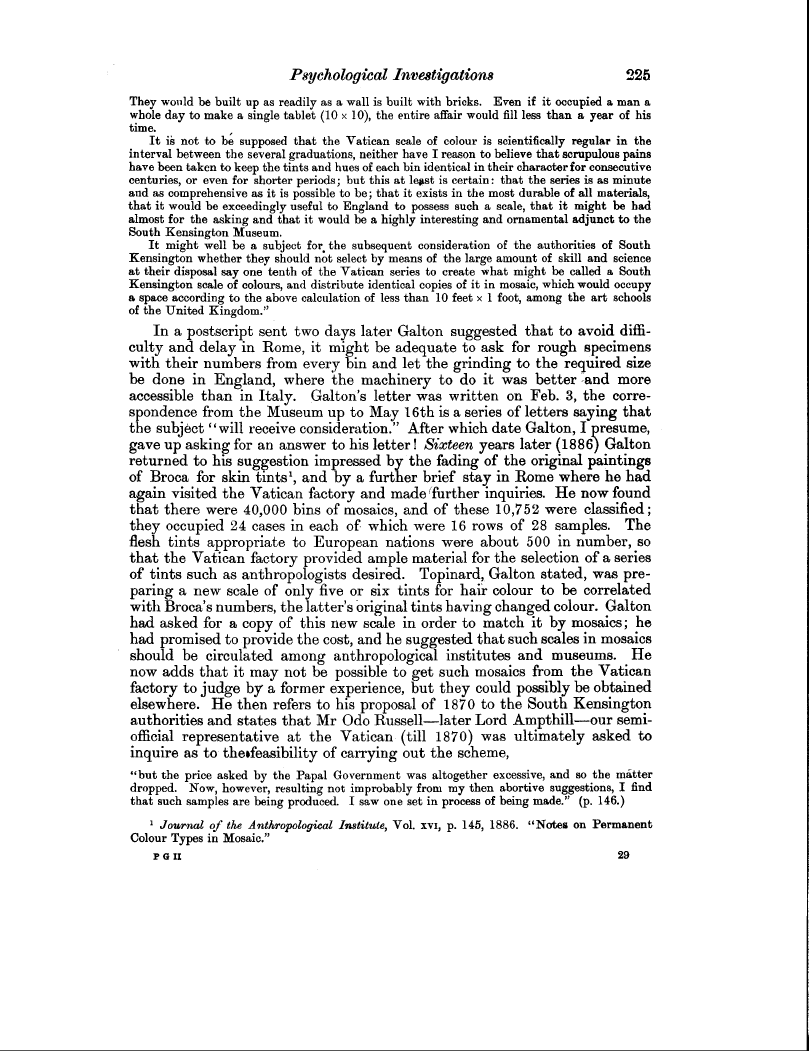Psychological Investigations 225
They would be built up as readily as a wall is built with bricks. Even if it occupied a man a whole day to make a single tablet (10 x 10), the entire affair would fill less than a year of his time.
It is not to be supposed that the Vatican scale of colour is scientifically regular in the interval between the several graduations, neither have I reason to believe that scrupulous pains have been taken to keep the tints and hues of each bin identical in their character for consecutive centuries, or even for shorter periods; but this at lest is certain: that the series is as minute and as comprehensive as it is possible to be; that it exists in the most durable of all materials, that it would be exceedingly useful to England to possess such a scale, that it might be had almost for the asking and that it would be a highly interesting and ornamental adjunct to the South Kensington Museum.
It might well be a subject for, the subsequent consideration of the authorities of South Kensington whether they should not select by means of the large amount of skill and science at their disposal say one tenth of the Vatican series to create what might be called a South Kensington scale of colours, and distribute identical copies of it in mosaic, which would occupy a space according to the above calculation of less than 10 feet x 1 foot, among the art schools
of the United Kingdom."
In a postscript sent two days later Galton suggested that to avoid difficulty and delay in Rome, it might be adequate to ask for rough specimens with their numbers from every bin and let the grinding to the required size be done in England, where the machinery to do it was better -and more accessible than in Italy. Galton's letter was written on Feb. 3, the correspondence from the Museum up to May 16th is a series of letters saying that the subject "will receive consideration." After which date Galton, I presume, gave up asking for an answer to his letter! Sixteen years later (1886) Galton returned to his suggestion impressed by the fading of the original paintings of Broca for skin tints 1, and by a further brief stay in Rome where he had again visited the Vatican factory and made 'further inquiries. He now found that there were 40,000 bins of mosaics, and of these 10,752 were classified; they occupied 24 cases in each of which were 16 rows of 28 samples. The flesh tints appropriate to European nations were about 500 in number, so that the Vatican factory provided ample material for the selection of a series of tints such as anthropologists desired. Topinard, Galton stated, was preparing a new scale of only five or six tints for hair colour to be correlated with Broca's numbers, the latter's original tints having changed colour. Galton had asked for a copy of this new scale in order to match it by mosaics; he had promised to provide the cost, and he suggested that such scales in mosaics should be circulated among anthropological institutes and museums. He now adds that it may not be possible to get such mosaics from the Vatican factory to judge by a former experience, but they could possibly be obtained elsewhere. He then refers to his proposal of 1870 to the South Kensington authorities and states that Mr Odo Russell-later Lord Ampthill-our semiofficial representative at the Vatican (till 1870) was ultimately asked to inquire as to the feasibility of carrying out the scheme,
"but the price asked by the Papal Government was altogether excessive, and so the matter dropped. Now, however, resulting not improbably from my then abortive suggestions, I find that such samples are being produced. I saw one set in process of being made." (p. 146.)
1 Journal of the Anthropological Institute, Vol. xvi, p. 145, 1886. "Notes on Permanent Colour Types in Mosaic."
P O 11 29

